|
2023 State of the Ecosystem Reports
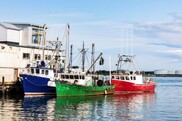
The 2023 State of the Ecosystem Reports are live! They show continuing physical, chemical, and biological changes in coastal Mid-Atlantic and New England ecosystems. Environmental conditions continue to push historical boundaries, altering the ecosystems, their inhabitants, and their productivity.
|
Woods Hole Science Aquarium Update
Atlantic Salmon Smolt Survey Underway
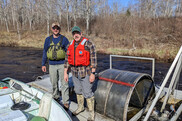
This year marks 27 years of collaboration with Maine Department of Marine Resources to monitor Atlantic salmon migrating down Maine’s Narraguagus River to the ocean. From late April to early June, we use screw traps to estimate the number of smolts exiting the river and collect other biological data. Long-term monitoring surveys like this help us understand how climate change impacts the timing of smolt migration. The team developed a model that linked fish movements to temperatures near juvenile salmon nursery areas. This study provides managers with a tool to annually refine protective measures at dams. What other threats do Atlantic salmon face? Play the animation to find out.
|
Tagged Shark Recaptured in United Kingdom
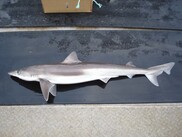
One of our Apex Predator Program’s tagged sharks was recently recaptured in the English Channel after nearly 25 years! In June 1998, a tope shark—also called school shark, soupfin shark, and snapper shark—was tagged just east of the Isle of Wight by one of our international volunteers, a recreational angler. Last month, the Sussex Inshore Fisheries and Conservation Authority reported that a commercial gillnetter caught this shark in March, approximately 4 nautical miles west of its tagging location. This is the longest-at-liberty tope shark since our Cooperative Shark Tagging Program began in 1962. We only have one species with a longer time at liberty, a sandbar shark at liberty for almost 28 years. Our tagging program has tagged 85 tope sharks—this recapture is just 1 of 14 to date. While these sharks aren’t found in our region, they can be found off the West Coast of the United States and in much of the Eastern Pacific, Western Pacific, Western Indian Ocean, and Eastern Atlantic, including the British Isles.
|
National Seafood Marketing Survey
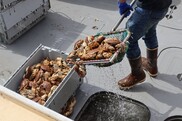
Are you a commercial seafood harvester? If so, please take this survey about national seafood marketing practices. We will use the survey results to better understand how our country’s commercial seafood harvesters market their catch. The research team hope survey findings will help increase visibility on domestic seafood and the role seafood harvesters play in supporting our food system. There’s a recording of an informational webinar about the survey available for viewing. This survey is led by NOAA Fisheries, the University of Maine, and the U.S. Department of Agriculture. It ends July 2023.
|
North Atlantic Right Whale Acoustic Reports
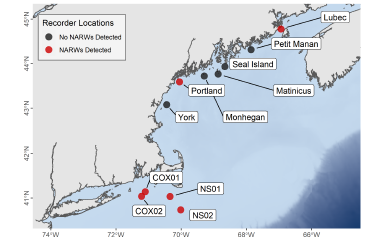
Scientists at our science center use passive acoustics in a variety of ways, including documenting the presence of endangered North Atlantic right whales in our region. Their findings from January 2020 to June 2022 are now available in these reports. They can also be found in our Passive Acoustic Cetacean Map. Only vocally-active individuals calling within range of passive acoustic recorders can be detected and documented. Animals that are silent or calling beyond the range of recorders can’t be detected and are not represented in these reports. These reports help inform management decisions, address questions from the public, and more.
|
Tautog Aquaculture Research
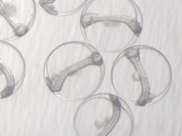
Over the last several months, scientists at our Sandy Hook Lab have been working with Dan Ward of Ward Aquafarms on an aquaculture tautog study. The goals are to find the best conditions for spawning of adults and for rearing embryos, larvae, and juveniles. The research team have been exposing embryos and early larvae to a wide range of temperatures, stocking densities, tank size and style, and prey quality and quantity. For the juvenile stage part of the study, they’ll transfer them to Ward Aquafarms. There they intend to identify the best conditions for growing juveniles into adults. Aquacultured tautog offer a year-round supply of market-size fish, boosting regional economies while offsetting fishing pressures. This research is funded by the Northeast Regional Aquaculture Center and the joint project agreement between NOAA and the Ministry of Oceans and Fisheries of the Republic of Korea.
|
Senator Murphy and Others Tour the Milford Lab
Director’s Message
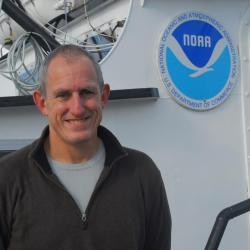
The Northeast Fisheries Science Center hosted the National Stock Assessment Workshop and the Maturity Assessment, Reproductive Variability, and Life Strategies Workshop in early May. This was the first time these two communities of scientists have come together in one location. Research fishery biologist Jon Deroba from our Population Dynamics Branch and the chief of our Population Biology Branch, Rich McBride represented our science center on the steering committee. They helped plan the training day, presentations and posters, keynote speaker, and other workshop activities. A number of our scientists presented their work at each of the workshops. Holding these two workshops together emphasizes the importance of life history data to stock assessments and the importance of stock assessments to developing scientific advice. This effort improves our science and supports our stakeholders and partners.
|
|
|
Upcoming Events and Meetings
May 31: Atlantic cod TOR1 subgroup meeting
Jun 1: Black sea bass working group meeting
Jun 7: Yellowtail flounder working group meeting
Jun 14: Atlantic cod TOR1 subgroup meeting
Jun 28: Ambrose Jearld, Jr. Lecture Golden tilefish working group meeting
|
|
Upcoming Deadlines
Jun 5: Proposed incidental take regulations (Coastal Virginia Offshore Wind Commercial Project) public comments
Jul: National Seafood Marketing Survey
Jul 31: Commercial Fishing Business Cost Survey (online and interviews only)
|
|
|
|
|